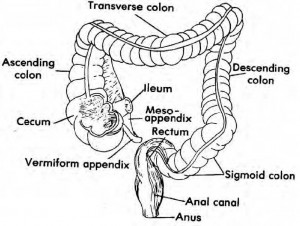a. Definition. Appendicitis is the inflammation of the vermiform appendix.
The appendix fills with food and empties regularly. Because its lumen is quite small, it empties irregularly and is prone to obstruction. The obstruction sets off an inflammatory process that may lead to infection, necrosis, and perforation.

b. Signs and Symptoms.
(1) Generalized abdominal pain that localizes in the right lower quadrant.
(2) Anorexia.
(3) Nausea and vomiting.
(4) Abdominal rigidity or guarding.
(5) Rebound tenderness.
(6) Fever.
(7) Elevated white blood cell count.
c. Nursing Implications.
(1) Administer IV fluids as ordered to maintain hydration.
(2) Keep the patient NPO until symptoms subside and/or surgery is ruled out.
(3) Position the patient in Fowler’s or semi-Fowler’s position. This position relaxes the abdominal muscles and reduces pain.
(4) Never apply heat to the abdomen, as this may cause the appendix to rupture.
(5) Analgesics are normally withheld since they mask symptoms.
d. Treatment. Treatment of choice is surgical removal of the appendix, especially if rupture is suspected or imminent.
(1) If the appendix can be removed before it ruptures, the post-op course is generally uncomplicated. The wound is closed and the patient is usually discharged within a week.
(2) If rupture has occurred, the wound is often left open to drain. The patient must be observed for signs and symptoms of obstruction, peritonitis, hemorrhage, or abscess.
